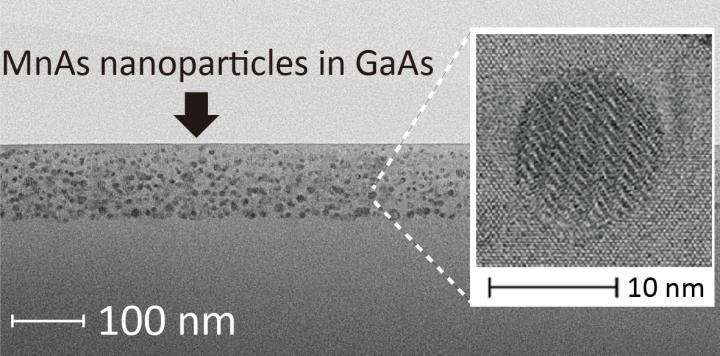Mar 6 2019
For the first time, scientists have proved a new method to carry out functions vital to future computation three orders of magnitude faster than existing commercial devices. The team headed by Associate Professor Shinobu Ohya, has developed a nanoscale spintronic semiconductor device that can partly switch between specific magnetic states trillions of times a second (terahertz— THz), far over frequencies of present-day devices.
 Transmission electron microscope images of MnAs nanoparticles in GaAs. (Image Credit: ©2019 Ohya Laboratory)
Transmission electron microscope images of MnAs nanoparticles in GaAs. (Image Credit: ©2019 Ohya Laboratory)
There is a high probability an individual would have bought a smartphone or computer sometime in the last ten years. Upon reading the description, they may have seen the speed of such devices is mostly measured in gigahertz (GHz). Currently, most devices are about a few gigahertz. But progress fast-tracks and new ways are pursued to boost the frequency and performance of devices. To find a solution, scientists at the University of Tokyo’s Graduate School of Engineering and Graduate School of Frontier Sciences explore the upcoming field of spintronics.
I hope our research leads to spintronic-based logic and memory devices. Within decades people should see spintronic smartphones and data centers. We would realize incredible performance gains in areas such as artificial intelligence and beyond.
Shinobu Ohya, Associate Professor, University of Tokyo.
Spintronics, aka "spin electronics," manipulates an intrinsic property of electrons known as spin,—accountable for magnetic behavior—to carry out the functions. For instance, computation depends on switchable states of a physical material as a means to convey information. Notably, the 1 and 0 comprising binary code are characterized by magnetic states of a magnetic metal in a hard drive or voltage levels in communication wires. The faster the switch between states, the better the performance of the device. In spintronic devices, discrete spin magnetization states signify binary digits.
One way scientists make this property is to irradiate a particular magnetic material with short but high-frequency pulses of terahertz radiation, like that of airport body scanners. The radiation flips electron spins in this material—ferromagnetic manganese arsenide (MnAs)—and therefore its magnetization, in under a picosecond, three orders of magnitude faster than transistors switch in microchips. Other scientists have tried this before but the magnetic variation in response to the pulses was just 1%, too small to be of real-world use.
At present, however, Ohya and his team effectively showed a larger magnitude change in magnetization of MnAs nanoparticles exposed to terahertz pulses. This better response of 20% means it could be more beneficial in research and suggests probable future applications. Their trick was to exploit the electric component of the terahertz electromagnetic radiation instead of the magnetic component.
Until now researchers in this area used ferromagnetic metal films to study terahertz modulation of magnetization, but these impeded the radiation's energy. Instead, we embedded our ferromagnetic nanoparticles in a semiconductor film 100 nanometers thick. This hinders the radiation far less so the terahertz electric field uniformly reaches and flips the spins, and therefore magnetization, of the nanoparticles.
Shinobu Ohya, Associate Professor, University of Tokyo.